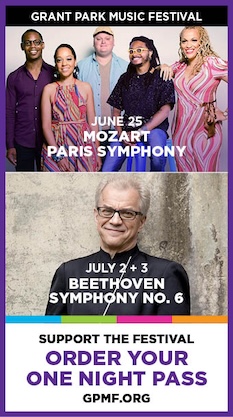Trio Settecento closes Chicago Early Music Festival in buoyant French style
Sunday’s matinee concert by Trio Settecento, the final day of Chicago’s first Early Music Festival, summed up everything the festival hoped to achieve.
The performance was free and held in a stunning visual space, the Tiffany-domed Preston Bradley Hall of the Chicago Cultural Center downtown. The repertoire of late 17th and early 18th century works offered a bracing look at one vital corner of early music, the French Baroque. And the performers—Rachel Barton Pine, violin; John Mark Rozendaal, viola da gamba, and David Schrader, harpsichord—are superb musicians.
The brainchild of the city’s innovative Department of Cultural Affairs, the six-day festival aimed to showcase Chicago’s increasingly lively early music scene. In a lineup that included the Newberry Consort and a production of Francesco Cavalli’s Giasone by Chicago Opera Theater, Trio Settecento’s concert was among the best of the best.
Pine, Rozendaal and Schrader have flourishing careers as solo performers and teachers, but they have been playing as a trio since 1996. Sunday’s concert had the relaxed, energized atmosphere of gifted friends looking forward to playing chamber music together.
Titled “Fetes Galantes,” the concert included works by Lully, Couperin, Rameau, Marin Marais and others. It opened with an assortment of 11 short pieces by those composers as well as Jean-Baptiste-Antoine. After intermission came later works by Jean-Fery Rebel, Jean Marie Leclair and Rameau written in a more flowing, Italianate style. The performers offered brief, illuminating comments before some of the pieces.
French Baroque music has been in our ears for decades, thanks to the revival of interest in early music that began in the 1950s. But as the first half of Trio Settecento’s concert made clear, it can still sound intriguingly exotic.
The tightly woven chords and runs from Schrader’s harpsichord had the insistent, staccato rush of wind-blown rain. Rozendaal’s viola da gamba was impassioned at times, but to ears used to a modern cello, its slightly metallic sound was muted. These shadows were alluring, hinting at a private, unknown space whose secrets might or might not be revealed.
Pine’s violin was more assertive, especially in the dazzlingly virtuoso closing work, Leclair’s Sonata in Sol-majeur, Op. 5. But its focused tone was bright and almost fiddle-like in the hearty dances on the program’s first half.
The French Baroque is all about dance, and the three players happily dug into its high spirits and elegant syncopations. Rhythms were endlessly infectious, whether in the stately, unhurried pace of Lully’s Entrée pour Vertumne or the merry skips of the Allemande from Couperin’s Troisieme Concert.
In many of the works the three musical lines were tightly woven, and Pine, Rozendaal and Schrader were highly responsive to each other. Picking up fragments of a melody or adding a new rhythmic layer, they played with seamless ease.
In the second half, each of the instruments moved into the spotlight. In Rameau’s Quatrieme Concert, the harpsichord’s tricky rhythms and cascading chords were integral to the melodic line rather than mere virtuoso display. Rozendaal’s viola da gamba was dark, with an almost tortured growling voice, in a sonata by Rebel.
Posted in Uncategorized


